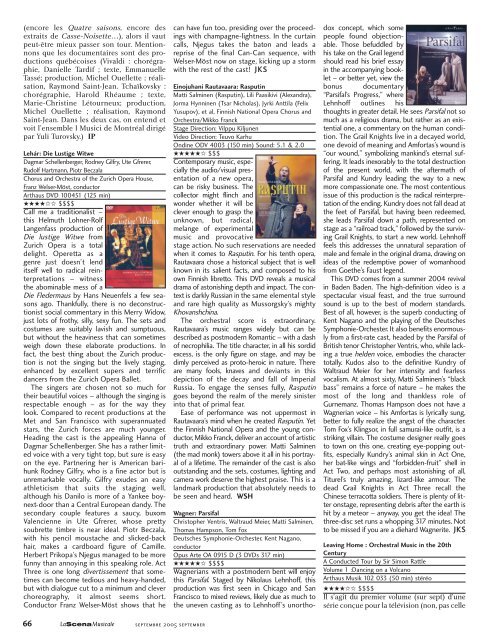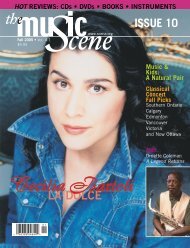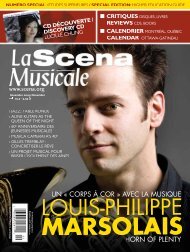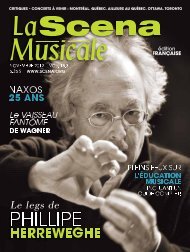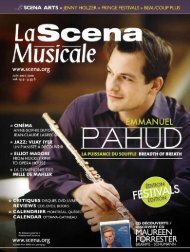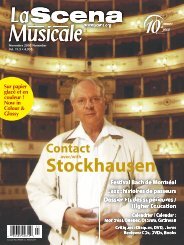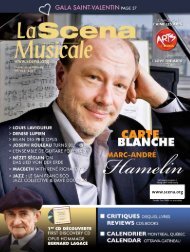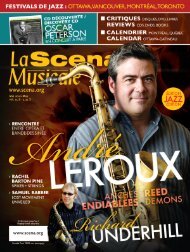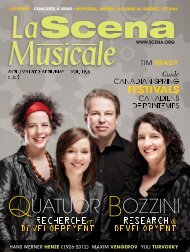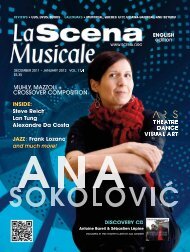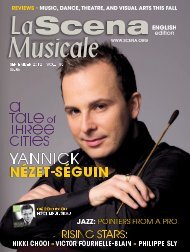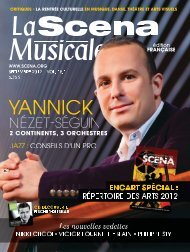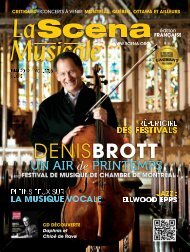You also want an ePaper? Increase the reach of your titles
YUMPU automatically turns print PDFs into web optimized ePapers that Google loves.
(encore les Quatre saisons, encore des<br />
extraits de Casse-Noisette…), alors il vaut<br />
peut-être mieux passer son tour. Mentionnons<br />
que les documentaires sont des productions<br />
québécoises (Vivaldi : chorégraphie,<br />
Danielle Tardif ; texte, Emmanuelle<br />
Tassé; production, Michel Ouellette ; réalisation,<br />
Raymond Saint-Jean. Tchaïkovsky :<br />
chorégraphie, Harold Rhéaume ; texte,<br />
Marie-Christine Létourneux; production,<br />
Michel Ouellette ; réalisation, Raymond<br />
Saint-Jean. Dans les deux cas, on entend et<br />
voit l’ensemble I Musici de Montréal dirigé<br />
par Yuli Turovsky.) IP<br />
Lehár: Die Lustige Witwe<br />
Dagmar Schellenberger, Rodney Gilfry, Ute Gfrerer,<br />
Rudolf Hartmann, Piotr Beczala<br />
Chorus and Orchestra of the Zurich Opera House,<br />
Franz Welser-Möst, conductor<br />
Arthaus DVD 100451 (125 min)<br />
★★★★✩✩ $$$$<br />
Call me a traditionalist –<br />
this Helmuth Lohner-Rolf<br />
<strong>La</strong>ngenfass production of<br />
Die lustige Witwe from<br />
Zurich Opera is a total<br />
delight. Operetta as a<br />
genre just doesn’t lend<br />
itself well to radical reinterpretations<br />
– witness<br />
the abominable mess of a<br />
Die Fledermaus by Hans Neuenfels a few seasons<br />
ago. Thankfully, there is no deconstructionist<br />
social commentary in this Merry Widow,<br />
just lots of frothy, silly, sexy fun. The sets and<br />
costumes are suitably lavish and sumptuous,<br />
but without the heaviness that can sometimes<br />
weigh down these elaborate productions. In<br />
fact, the best thing about the Zurich production<br />
is not the singing but the lively staging,<br />
enhanced by excellent supers and terrific<br />
dancers from the Zurich Opera Ballet.<br />
The singers are chosen not so much for<br />
their beautiful voices – although the singing is<br />
respectable enough – as for the way they<br />
look. Compared to recent productions at the<br />
Met and San Francisco with superannuated<br />
stars, the Zurich forces are much younger.<br />
Heading the cast is the appealing Hanna of<br />
Dagmar Schellenberger. She has a rather limited<br />
voice with a very tight top, but sure is easy<br />
on the eye. Partnering her is American barihunk<br />
Rodney Gilfry, who is a fine actor but is<br />
unremarkable vocally. Gilfry exudes an easy<br />
athleticism that suits the staging well,<br />
although his Danilo is more of a Yankee boynext-door<br />
than a Central European dandy. The<br />
secondary couple features a saucy, buxom<br />
Valencienne in Ute Gfrerer, whose pretty<br />
soubrette timbre is near ideal. Piotr Beczala,<br />
with his pencil moustache and slicked-back<br />
hair, makes a cardboard figure of Camille.<br />
Herbert Prikopa’s Njegus managed to be more<br />
funny than annoying in this speaking role. Act<br />
Three is one long divertissement that sometimes<br />
can become tedious and heavy-handed,<br />
but with dialogue cut to a minimum and clever<br />
choreography, it almost seems short.<br />
Conductor Franz Welser-Möst shows that he<br />
66 septembre 2005 september<br />
can have fun too, presiding over the proceedings<br />
with champagne-lightness. In the curtain<br />
calls, Njegus takes the baton and leads a<br />
reprise of the final Can-Can sequence, with<br />
Welser-Möst now on stage, kicking up a storm<br />
with the rest of the cast! JKS<br />
Einojuhani Rautavaara: Rasputin<br />
Matti Salminen (Rasputin), Lili Paasikivi (Alexandra),<br />
Jorma Hynninen (Tsar Nicholas), Jyrki Anttila (Felix<br />
Yusupov), et al, Finnish National Opera Chorus and<br />
Orchestra/Mikko Franck<br />
Stage Direction: Vilppu Kiljunen<br />
Video Direction: Teuvo Karhu<br />
Ondine ODV 4003 (150 min) Sound: 5.1 & 2.0<br />
★★★★★✩ $$$<br />
Contemporary music, especially<br />
the audio/visual presentation<br />
of a new opera,<br />
can be risky business. The<br />
collector might flinch and<br />
wonder whether it will be<br />
clever enough to grasp the<br />
unknown, but radical,<br />
melange of experimental<br />
music and provocative<br />
stage action. No such reservations are needed<br />
when it comes to Rasputin. For his tenth opera,<br />
Rautavaara chose a historical subject that is well<br />
known in its salient facts, and composed to his<br />
own Finnish libretto. This DVD reveals a musical<br />
drama of astonishing depth and impact. The context<br />
is darkly Russian in the same elemental style<br />
and rare high quality as Mussorgsky’s mighty<br />
Khovanshchina.<br />
The orchestral score is extraordinary.<br />
Rautavaara’s music ranges widely but can be<br />
described as postmodern Romantic – with a dash<br />
of necrophilia. The title character, in all his sordid<br />
excess, is the only figure on stage, and may be<br />
dimly perceived as proto-heroic in nature. There<br />
are many fools, knaves and deviants in this<br />
depiction of the decay and fall of Imperial<br />
Russia. To engage the senses fully, Rasputin<br />
goes beyond the realm of the merely sinister<br />
into that of primal fear.<br />
Ease of performance was not uppermost in<br />
Rautavaara’s mind when he created Rasputin. Yet<br />
the Finnish National Opera and the young conductor,<br />
Mikko Franck, deliver an account of artistic<br />
truth and extraordinary power. Matti Salminen<br />
(the mad monk) towers above it all in his portrayal<br />
of a lifetime. The remainder of the cast is also<br />
outstanding and the sets, costumes, lighting and<br />
camera work deserve the highest praise. This is a<br />
landmark production that absolutely needs to<br />
be seen and heard. WSH<br />
Wagner: Parsifal<br />
Christopher Ventris, Waltraud Meier, Matti Salminen,<br />
Thomas Hampson, Tom Fox<br />
Deutsches Symphonie-Orchester, Kent Nagano,<br />
conductor<br />
Opus Arte OA 0915 D (3 DVDs 317 min)<br />
★★★★★✩ $$$$<br />
Wagnerians with a postmodern bent will enjoy<br />
this Parsifal. Staged by Nikolaus Lehnhoff, this<br />
production was first seen in Chicago and San<br />
Francisco to mixed reviews, likely due as much to<br />
the uneven casting as to Lehnhoff’s unortho-<br />
dox concept, which some<br />
people found objectionable.<br />
Those befuddled by<br />
his take on the Grail legend<br />
should read his brief essay<br />
in the accompanying booklet<br />
– or better yet, view the<br />
bonus documentary<br />
“Parsifal’s Progress,” where<br />
Lehnhoff outlines his<br />
thoughts in greater detail. He sees Parsifal not so<br />
much as a religious drama, but rather as an existential<br />
one, a commentary on the human condition.<br />
The Grail Knights live in a decayed world,<br />
one devoid of meaning and Amfortas’s wound is<br />
“our wound,” symbolizing mankind’s eternal suffering.<br />
It leads inexorably to the total destruction<br />
of the present world, with the aftermath of<br />
Parsifal and Kundry leading the way to a new,<br />
more compassionate one. The most contentious<br />
issue of this production is the radical reinterpretation<br />
of the ending. Kundry does not fall dead at<br />
the feet of Parsifal, but having been redeemed,<br />
she leads Parsifal down a path, represented on<br />
stage as a “railroad track,” followed by the surviving<br />
Grail Knights, to start a new world. Lehnhoff<br />
feels this addresses the unnatural separation of<br />
male and female in the original drama, drawing on<br />
ideas of the redemptive power of womanhood<br />
from Goethe’s Faust legend.<br />
This DVD comes from a summer 2004 revival<br />
in Baden Baden. The high-definition video is a<br />
spectacular visual feast, and the true surround<br />
sound is up to the best of modern standards.<br />
Best of all, however, is the superb conducting of<br />
Kent Nagano and the playing of the Deutsches<br />
Symphonie-Orchester. It also benefits enormously<br />
from a first-rate cast, headed by the Parsifal of<br />
British tenor Christopher Ventris, who, while lacking<br />
a true helden voice, embodies the character<br />
totally. Kudos also to the definitive Kundry of<br />
Waltraud Meier for her intensity and fearless<br />
vocalism. At almost sixty, Matti Salminen’s “black<br />
bass” remains a force of nature – he makes the<br />
most of the long and thankless role of<br />
Gurnemanz. Thomas Hampson does not have a<br />
Wagnerian voice – his Amfortas is lyrically sung,<br />
better to fully realize the angst of the character.<br />
Tom Fox’s Klingsor, in full samurai-like outfit, is a<br />
striking villain. The costume designer really goes<br />
to town on this one, creating eye-popping outfits,<br />
especially Kundry’s animal skin in Act One,<br />
her bat-like wings and “forbidden-fruit” shell in<br />
Act Two, and perhaps most astonishing of all,<br />
Titurel’s truly amazing, lizard-like armour. The<br />
dead Grail Knights in Act Three recall the<br />
Chinese terracotta soldiers. There is plenty of litter<br />
onstage, representing debris after the earth is<br />
hit by a meteor – anyway, you get the idea! The<br />
three-disc set runs a whopping 317 minutes. Not<br />
to be missed if you are a diehard Wagnerite. JKS<br />
Leaving Home : Orchestral Music in the 20th<br />
Century<br />
A Conducted Tour by Sir Simon Rattle<br />
Volume 1 :Dancing on a Volcano<br />
Arthaus Musik 102 033 (50 min) stéréo<br />
★★★★✩✩ $$$$<br />
Il s’agit du premier volume (sur sept) d’une<br />
série conçue pour la télévision (non, pas celle


